Various treatment options
The Department of Neuroradiology offers several treatment options:
Coilembolization
During coil embolization, a fine microcatheter is inserted through the blood vessels into the aneurysm. The aneurysm is then filled with platinum coils, which leads to rapid blood clotting and completely eliminates the aneurysm. Coil embolization with the platinum coils used today was first performed in 1990. It subsequently proved to be highly effective with few complications and is now the most commonly used form of treatment for intracranial aneurysms.
Flow-Diverter Stent
In this therapy, a flexible, very fine-meshed metal mesh is placed over the aneurysm. The advantage is that larger diseased vessel sections with several aneurysms can be treated in one step. After treatment with a flow diverter stent, a blood-thinning medication must be taken for one year.



